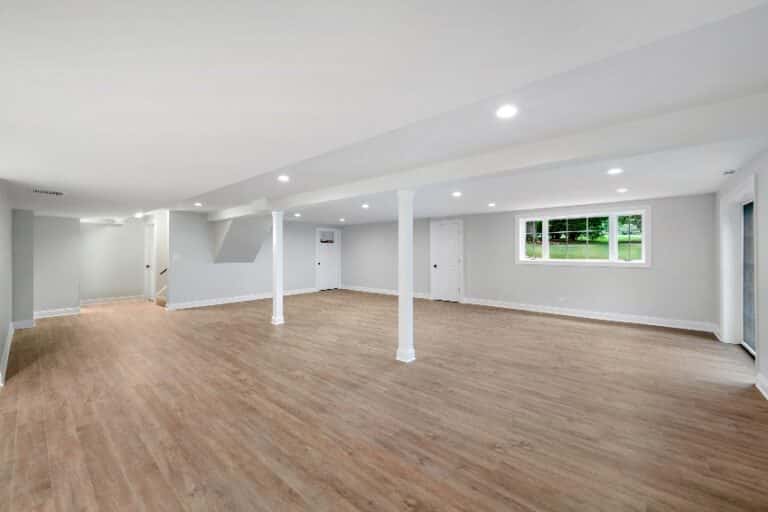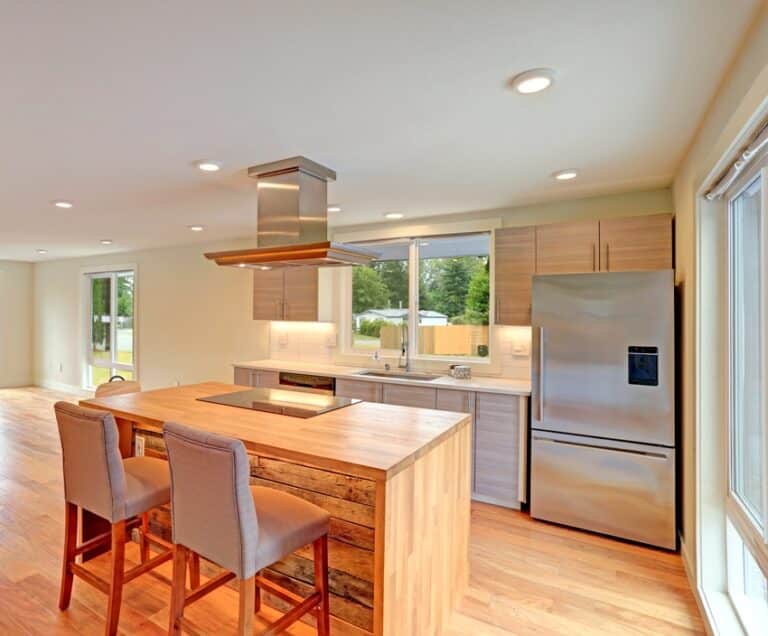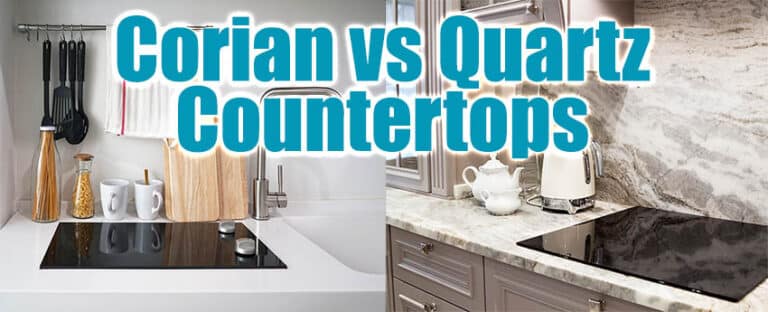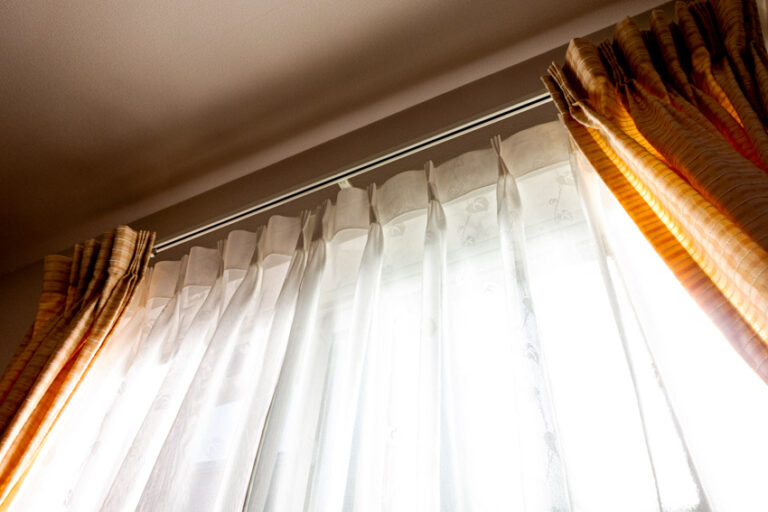Porcelain Wood Tile Pros and Cons
With so many technological advancements today, it’s no longer impossible to have building materials that provide long-lasting durability. Despite these developments, natural materials are still a much-loved preference because of their unmatched beauty. What if you can have a gorgeous organic look while enjoying a high-performance material? Porcelain wood tiles provide these qualities exactly without the disadvantages of natural wood.
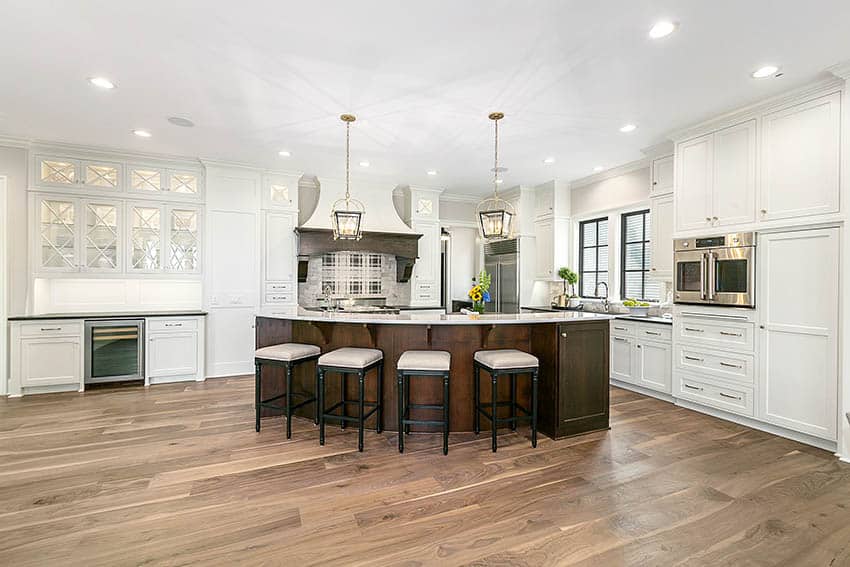
Porcelain wood tiles are a cost-effective alternative to your hardwood and are resistant to water, stain, rot, fire deformation, and UV resistance. With its realistic wood look, this type of tile flooring can be used in kitchens, living rooms, and bathrooms with great results.
What is Porcelain Wood Tile?
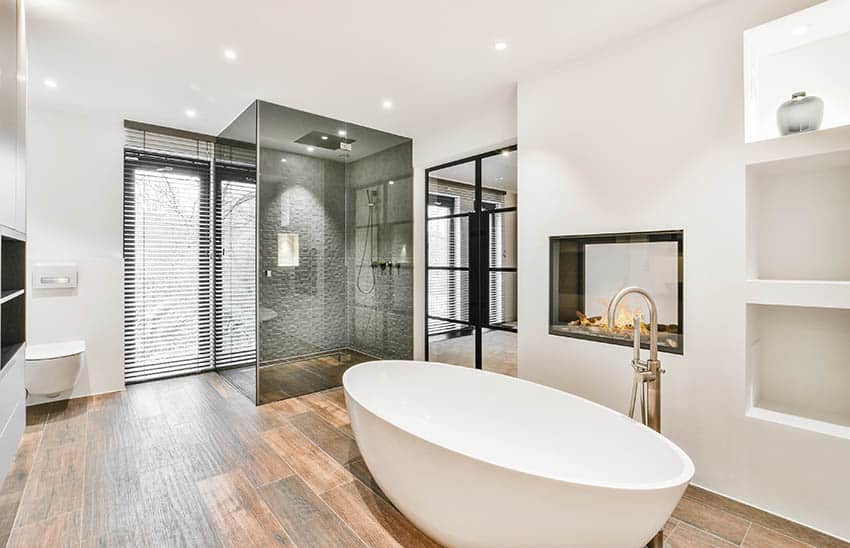
Like any type of porcelain tile, porcelain wood tiles are made from refined clay or feldspar that is dried and pressed to shape under incredibly high pressure and baked up to 2500 Fahrenheit. The process leaves the surface less porous and removes moisture and water from the material. Since it has less porosity, it is impervious to water and moisture damage.
Porcelain wood tiles have the usual properties of porcelain but simulate the look of the natural beauty of real wooden flooring. Porcelain tiles that look like wood are gorgeous and durable and are popular for both residential and commercial spaces.
The hardwearing feature of porcelain and the wide amount of colors and design choices make it a more versatile choice for any flooring tile patterns and styles owners are aiming for. There is timber-style flooring that can even be used outdoors, such as in swimming pools or gardens, but make sure to check with the manufacturer for your porcelain tile suitability.
Although some manufacturers have their own non-standard sizes, most square tiles come in the following sizes: 2, 3, 4, 6, 8, 12, 16, 18, and 24 inches; most products made specifically for floors have 6 Larger sizes of inches and above.
If you’re evaluating whether porcelain wood tiles are a viable option for your home or business, then its best to understand its following benefits and drawbacks. Here are the pros and cons of porcelain wood tile, starting with the pros.
Porcelain Wood-Look Tile Pros
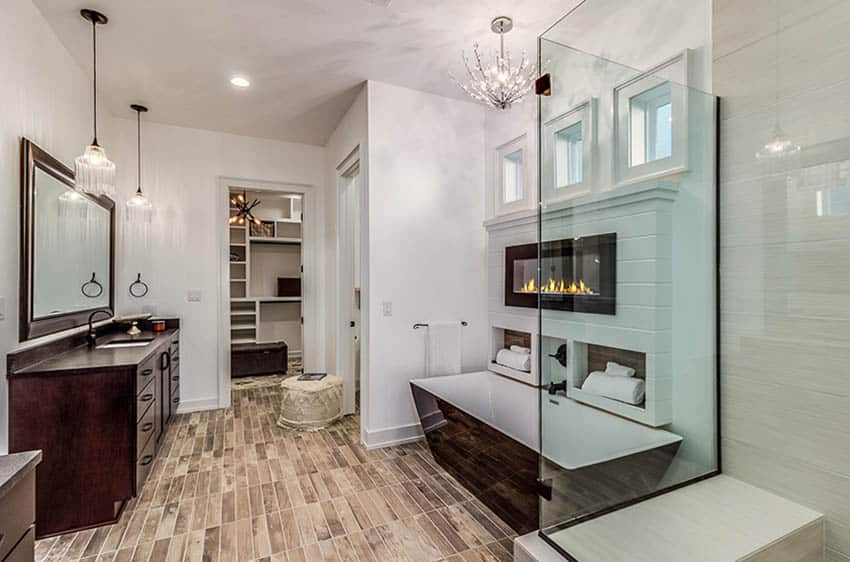
Tougher than most floor surfaces. Quality tiles that are treated and installed correctly can last on an average of 50 years and even more in a residential setting. Premium wood-style tiling made of kaolin can last as much as 75 to 100 years with proper installation.
Ideal for pet owners. Since porcelain tiles that look like wood are basically man-made stones, you don’t have to worry about splinters and other debris that can cause injury to your pets.
Better indoor air quality. Off-gassing from hardwood treatments can cause respiratory problems to occupants. With porcelain and a low VOC content grouting you’ll never have problems with air contaminants.
In addition, its surfaces do not harbor mold and are virtually easy to clean, preventing dust build-up on your floors.
Wide range of flooring design options. There are many sizes and designs to choose from to match your desired look, and you’ll find that these tiles are readily available locally.
Aside from color and size, you can choose the different degrees of gloss for your porcelain wood-like flooring. Matte, glossy, semi-gloss, or high-gloss are the general types of surface finish for stone tiles.
Gorgeous and luxurious appeal. Wood floors have that unmatched appeal and versatility, giving a warm and comfortable ambiance to the space, and baked kaolin clay timber style tiling captures that natural look.
Moreover, newly improved designs can give you more variations and natural-looking tiles that you may never be able to tell the difference between hardwood and baked clay timber look tiling. Read more about the types of hardwood flooring here.
Tile that can be used outdoors. Ceramics and most other stones can crack during freezing temperatures and other extreme conditions, while porcelain’s impervious surface and less porosity prevent water from seeping through.
For this reason, you’ll find some manufacturers that provide wall tiles made of baked clay for outdoor use, which can be installed on patios and swimming pool areas. Be sure to check with your manufacturer’s specifications before deciding to install wood-style tiling made of baked clay outdoors.
Low maintenance flooring. Regular maintenance of this type is easy- by mopping and sweeping off the dirt. And unlike hardwood floors, you don’t need the costly refinishing of your stone surfaces to maintain their sheen.
You can also vacuum the tiles without any issues, and it is not sensitive to detergents and cleaning agents. But be sure to ask for cleaning and maintenance instructions from your supplier, as not all products are equal.
Resistant to staining. High-quality and newly improved porcelain timber-style surfaces are virtually stain-resistant. This makes it ideal as a flooring material for kitchens and bathrooms. See more types of kitchen floor tiles here.
Cost-effective for homes & commercial spaces. These tiles may be costlier to install than other floor surfaces, but it’s a worthwhile investment, especially for large commercial spaces. It’s so easy to maintain and clean and can withstand high-traffic areas because of its high durability. And reduces the need for periodic resurfacing of floors.
Achieve a cohesive design. One of the problems with natural wood flooring is that you can’t install them in bathrooms and other high-moisture areas. With wood-like tiles, you can install them virtually anywhere, creating a more cohesive and unified flooring material. See more bathroom floor tile ideas here.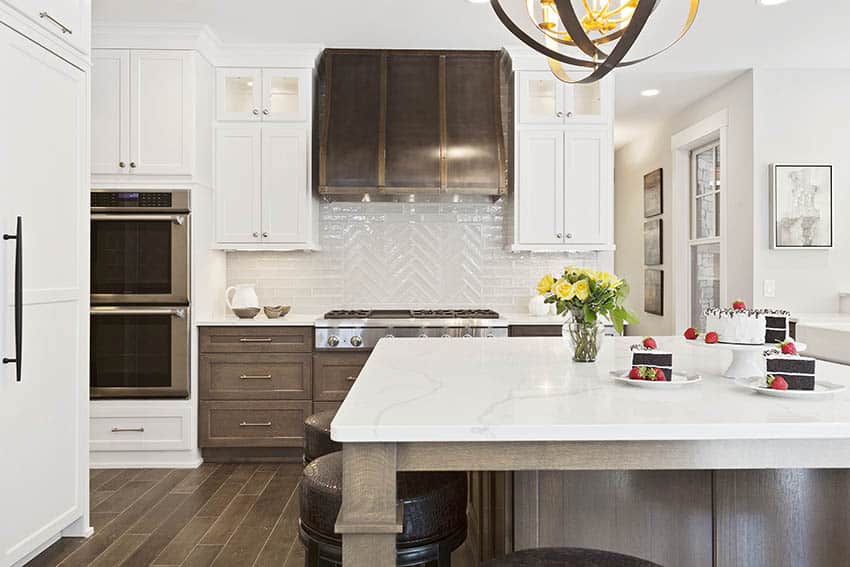
Porcelain Wood-Look Tile Cons
It is hard to replace the tile once chipped. Though very durable, extreme circumstances will cause your wood-like flooring to chip off.
If this happens, it can be hard to fix the damaged tile, especially if you have your vitrified flooring for many years, as the same design or style may no longer be available. Unlike marble or granite, where you can spot and treat the damage.
It can be costly and hard to install. One of the cons of this type of flooring design is it can be relatively inexpensive to purchase but labor-intensive to install and thus costlier. Unlike ceramic, porcelain tiles, in general, are heavy and require special mortars and tools during installation.
Expect to have a labor-intensive and time-consuming installation. On top of these, you’ll the labor cost can be higher than installing ceramic materials.
Notoriously cold flooring. This is a serious concern for homeowners as tiles will feel cold on bare feet and will also heat up quickly when subjected to direct sunlight.
Consider installing floor heating; not only does it keep your floors comfortably warm, but it also saves you from energy costs in the long run, especially during winter.
Slippery surface. A downside of having a smooth surface is that it can get slippery, especially when wet. To prevent this, consider adding tile glazing or anti-slip adhesive treads on trafficked areas.
You may also place area rugs on your tiles, such as areas with changed levels or floor surfaces prone to spills.
Tile grout can be stained. While they are stain-resistant, your grout in between is not immune to staining and chipping off. Best to use anti-stain additives on your grout to prevent unwanted stains.
Higher initial flooring costs. Expect to pay 60 to 70 percent more on material cost than ceramic tiles when installing wooden style flooring, and on top of it are the higher labor costs for installation.
How Durable is Porcelain Tile That Looks Like Wood?

This tyling is a tough and hard-wearing flooring because of its material makeup and manufacturing process due to its high density and reduced porosity. These flooring are favorable not only for residential use but also for commercial applications in medium- to high-traffic areas.
As not all vitrified tiling is made equal, find a reputable line that has the PEI (Porcelain Enamel Institute) rating. A test recommended by the ASTM (American Society for Testing and Materials)
The rate ranges from Group 0 to Group 5 or PEI 5, which starts from Group 0, which has the lowest rating, and Group 5 has the highest durability rating.
Take note, though, that the following ratings only measure the tiles’ strength and application and do not define the overall quality of the tile.
Does Porcelain Tile Scratch?

Granite’s Moh’s hardness test shows the ceramic tile having around 6 to 6.5, while porcelain received a 7 to 8 average rating.
Another advantage of these tiles is that you have a uniform color throughout your tiles, which, even when scratched, won’t be noticeable.
Does Wood-Look Porcelain Crack Easily?
This material is a very tough flooring material, and it is unlikely to crack easily, even in high-traffic areas. But if cracks have suddenly shown on your flooring, it may be a case of other underlying issues.
Poor workmanship and substandard installation practices are the most common reasons for tile cracking. Cracking can also be caused by extreme temperature changes as well as weak or unstable substrates.
Loading too much weight can also cause hairline cracks on your tiles.
Which is Better Porcelain Or Ceramic Tile?
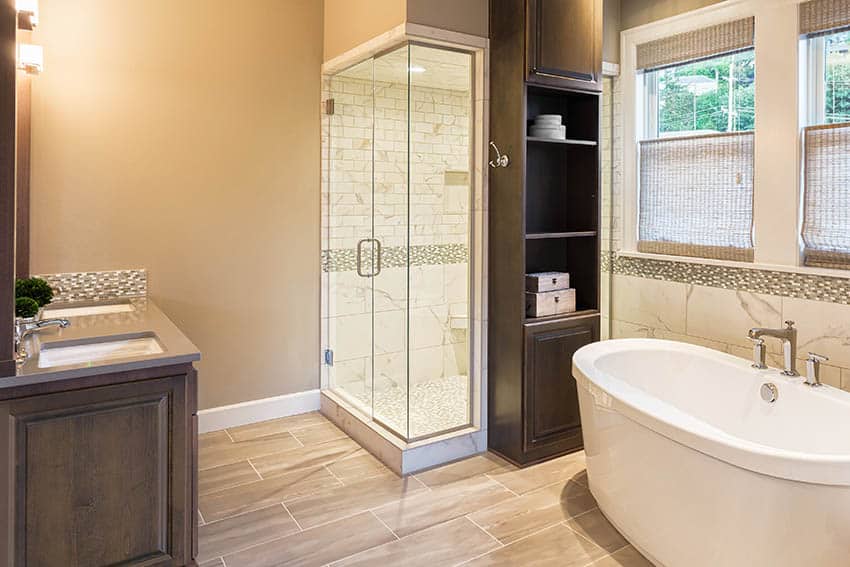
Ceramic and vitrified timber-style tiling can look similar at the onset, and both offer a durable surface as long as the tile is glazed.
The advantage of porcelain over ceramic tiling is that it is denser, water-resistant, and does not show imperfections easily, as the surface color is similar underneath the tile. The advantage of ceramic flooring, though, is that it is more affordable.
Both porcelain and ceramic woodlike flooring are more affordable compared to most tiling materials, but since pricing depends heavily on the density of the material, the former is more expensive than ceramic. You’ll spend around 60 to 70 percent less if you choose ceramic flooring over kaolin-based flooring.
What do you think of these baked clay timber-style tiling pros and cons? Is there anything we missed? If so, let us know in the comments; for another related article, visit our types of bathroom tiles gallery.


